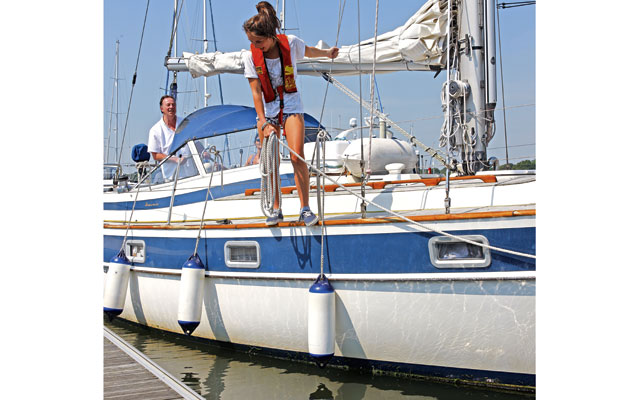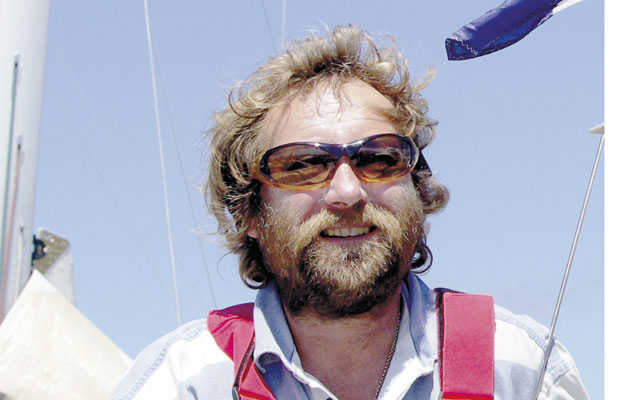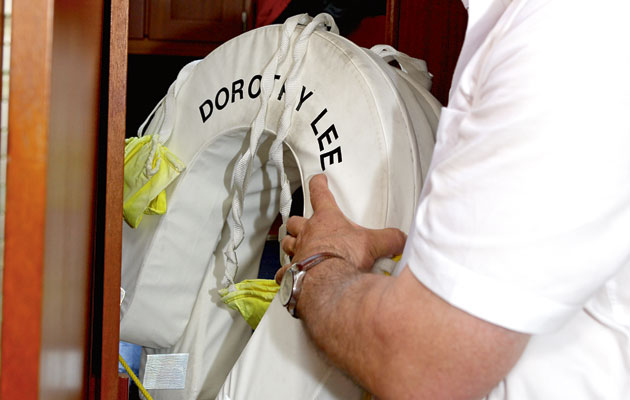The RYA Yachtmaster is a good test of advanced seamanship, but the best sailors know that there will always be lessons to be learned from experience
Yachtmaster Plus – Lessons learned from experience Part 4
SAIL HANDLING
Using a third sheet
Julian Mandiwall
Yachtmaster instructor Julian Mandiwall is a former director of RYA Sailability
When poling a foresail out for downwind use, put in a third sheet so the boat remains easily manoeuvrable – important in crowded areas like the Solent. Attach it to the sail and bring it back through the end of the spinnaker pole to avoid it rubbing on the guardrail. This leaves the normal port and starboard sheets ready to come into immediate use by just letting the ‘third’ sheet fly.
BOAT MANAGEMENT
Steaming kettles
Duncan Wells
RYA instructor Duncan Wells is principal of Westview Sailing. He sails a Hallberg-Rassy 352
Turn the spout of the boiling kettle so that it is running fore and aft and venting into open space within the saloon. If it is turned outboard, over time it will quietly steam away the headlining in that area of the galley.
Silence is golden
Duncan Wells
Tie off the mainsheet traveller car so that it doesn’t slam against the stops if the boat rolls. Quieten the cupboard doors by chocking them with tissue. The sawing sound of a warp tensioned against the toerail will disappear if you wedge a plastic bag between the warp and rail.
The heads will let your boat down
Duncan Wells
There is no excuse for stinky heads. It depends on the type of toilet you have, but, generally, you should run the ‘dry bowl’ and pump all water out after use. Then pee. Then pump ten times to get enough water in and remove the pee. Pump seven times to remove all water. Now there’s no water in the bowl to develop anaerobic bacteria and start smelling. The pump will run smoothly. Always close the seacocks on leaving the boat. Insist everyone who uses the heads sits down. Use shore-based facilities whenever you’re berthed alongside.
SAFETY
No heroics
Nigel Calder
Nigel Calder is author of the best-selling Boatowner’s Mechanical and Electrical Manual
Docking is one of the more stressful activities, especially in larger boats. It is important for the crew to understand that the boat is just an (expensive) toy and it is much better to break the toy than the crew, so no wild leaps for the dock, fending off or other heroics. If the skipper screws it up, let the skipper take the blame. It is also inadvisable to throw lines to unskilled shore personnel as they will probably promptly snub up and turn your nicely executed manoeuvre into a dock crashing session.
All aboard
Chris Tibbs
Sailing weather forecaster Chris Tibbs owns a J/105 and won the Azores and Back Race 2011
Keep everyone on board the boat. Good jackstays and harness/lifejackets are essential. In bad weather, extra lines near the companionway and helm are useful so that nobody is ever unclipped completely. The extra lines by the helm make it easier for the helmsman to maintain balance when hit by a wave from a different direction. Avoid leaving webbing jackstays on the deck when not using the boat as they degrade in sunlight. I like the idea of AIS man overboard systems as they tells where the person is rather than just where they fell in. Number safety equipment and give everyone a number. It is very easy with a big crew to go through the numbers to make sure everyone is on board rather than trying to remember names of unfamiliar people.
Check lifebuoys, danbouys, lights and other safety kit is working and connected correctly. Each year, I help check boats for the ARC and find that knowledge of how to use these essential pieces of kit is often poor. A man overboard sling is very useful –it’s easier to circle a person in the water than to come up alongside.
It is very difficult to get a cold, wet person out of the water and there is lots of gear on the market that looks great in a Force 3 but in stronger wind may be difficult to use. Practice is the only way you will be able to use it.
See our test of MOB retrieval and recovery kit
Love your lifejacket
Paul Boissier
RNLI chief executive Paul Boissier sails Snow Goose, an Island Packet 380, from Gosport
Become best friends with your lifejacket. It’s more useful if you wear it than leave it below. Crotch straps make it more comfortable and more effective in the water. Know how to fit it, use it and look after it. The RNLI says 10% of the lifejackets they see at Sea Safety clinics wouldn’t work because they’ve been poorly maintained.
Longlife lifebuoys
Duncan Wells
Don’t leave lifebuoys and lights on the back rail. They rot in the sun and the lights fill up with water, making them useless in an emergency. Keep safety gear inside when not in use. We only put lights out at night or in gloomy weather. Mine are 10 years old but you wouldn’t know it.













